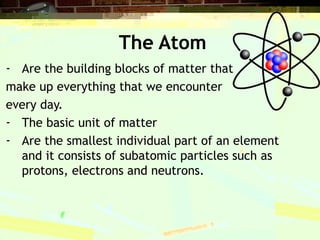The Atom
- 1. The Atom - Are the building blocks of matter that make up everything that we encounter every day. - The basic unit of matter - Are the smallest individual part of an element and it consists of subatomic particles such as protons, electrons and neutrons.
- 2. TIMELINE OF ATOMIC NATURE He proposed that all substances are composed of four elements such as air, earth, fire and water in different proportion. fire air water earth Aristotle 322 ŌĆō 384 BC
- 3. Empedocles divided matter into four elements such as air, earth, fire and water. Approximately 450 BC
- 4. ŌĆó Democritus and Leucippus ŌĆō proposed that everything is composed of small bit of matter that is indivisible and call it atom (atomos ŌĆō ŌĆ£indivisibleŌĆØ) 500 BC
- 5. ŌĆó Lavoisier clarified the concept of an element as a simple substance that could not be broken down by any known method of chemical analysis, and he devised a theory of the formation of chemical compounds from elements. 1777
- 6. ŌĆó Coulomb explained that like fluids repel and unlike attract. This was important in the development of the theory of absolute measurement, and had a great impact on electrical potential. 1780
- 7. (The Solid Sphere Model) ŌĆō Billiard Ball Model - small solid sphere ŌĆō Developed notion of conservation of mass and that atoms combine in specific ratios DaltonŌĆÖs Atomic Theory1803
- 8. The postulates of this theory are the ff; 1. All matter is composed of extremely small, indivisible, indestructible particles called atoms. 2. All atoms of each element are exactly alike but they differ from atoms of the other elements. The atoms of different elements have different mass and properties.
- 9. The postulates of this theory are the ff; 3. When atoms of different elements combine to form a compound, the constituent atoms are always present in the same fixed numerical ratio.
- 10. The postulates of this theory are the ff; 4. A chemical reaction involves a rearrangement of atoms. No atom is created or destroyed.
- 11. Sir William Crookes - constructed the forerunner of the modern television picture tube in the 1870s to investigate the properties of cathode rays. - Crookes tube ŌĆō a vacuum discharge tube 1870
- 12. Wilhelm Roentgen - discovered X-ray by observing the fluorescence they produced. 1896
- 13. ŌĆó J.J. Thomson ŌĆō Plum Pudding Model - positive and negative particles dispersed throughout the atom ŌĆō Used Cathode Ray tubes to discover the electron - first subatomic particle discovered! 1898
- 14. Cathode Ray Tube ŌĆó A tube that contains a stream of electrons going from a negative disk (cathode) to a positive disk. ŌĆó Deflected stream showed that electrons are negative.
- 15. Rutherford ŌĆō Nuclear Model of an atom ŌĆō Discovered dense positively charged nucleus of the atom while working with alpha particles ŌĆó Gold Foil Experiment
- 16. ŌĆó Neils Bohr - ŌĆō Planetary Model of an Atom ŌĆō Electrons travel in specific, circular orbits Neils Bohr and Arnold Sommerfeld - Arnold Sommerfeld improved BohrŌĆÖs model and introduced the concept of elliptical orbit.
















